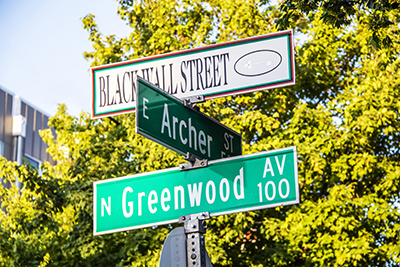The Tulsa Race Massacre Happened 99 Years Ago.
mob destroys 35-square-blocks of the black community, 300 killed, 8,000 left homeless
Posted on January 27, 2021
 Last year, the HBO series ‘Watchmen’ depicted the Tulsa Race Massacre, one of the worst outbreaks of racial violence in American history, in its series premiere.
Last year, the HBO series ‘Watchmen’ depicted the Tulsa Race Massacre, one of the worst outbreaks of racial violence in American history, in its series premiere.
The Tulsa Race Massacre receives scant mention in most history textbooks and some facts remain hazy — mystery persists about, for example, exactly how many people were killed and where they were buried. But there’s no question that it was one of the worst outbreaks of racial violence in American history: a horrific spree of murder, arson and looting inflicted by white residents upon the prosperous African-American community of Greenwood, followed by a shameless cover-up.
The HBO series “Watchmen,” which debuted Oct. 20, 2019, begins with a depiction of the Tulsa horror and suggests that its aftereffects could be a recurring plot point. In the show’s alternate history, unlike what actually happened, reparations had been paid to the victims and their descendants, and resentment about this lingers among white supremacists.
For useful background to all this, here is a collection of eyewitness accounts, official reports and subsequent reporting and commentary on the destruction of the thriving district once known as “Black Wall Street.”
‘Unearthing a Riot’
[The New York Times]
A wall of silence surrounded the Tulsa race riot, which was instigated in part by the city itself, reported Brent Staples, by permitting and aiding the looting, arson and murders in Greenwood. The law professor Alfred L. Brophy argued that city officials “made the riot worse” when police deputized hundreds from a lynch mob. The state legislator Don Ross, who had published the exposé “Profile of a Race Riot,” detailing Ku Klux Klan involvement, also found evidence of the mayor and the city commission plotting to “steal black land so that the ‘colored section’ could be pushed farther north,” he said.
‘Oklahoma Was Never Really O.K.’
[New York Magazine]
Frank Rich took a hard look at the legacy of the Rodgers and Hammerstein musical, and wonders about the whitewashing of American history pertaining to the Tulsa race riot, which was “still within recent memory” during its creation. “Or would have been had it not been purged from the record. And I mean literally purged,” he wrote. “The incident was not a part of the Oklahoma public schools’ curriculum until 2000, and only recently entered American-history textbooks.”
‘Timeline: The 1921 Tulsa Race Massacre’
Tracking the conditions leading up to, during, and following the 14-hour-period of May 31-June 1, 1921, such as the previous investigation into the corrupt police force and the arrest of a young black teenager for allegedly attacking a white female elevator operator (a case that was later dismissed). As the suspect was held in a courthouse cell, a large crowd gathered outside, leading to armed confrontation and looting. “At dawn, a force of ‘citizens, police and members of the National Guard,’ numbering perhaps 1,500, moved into Greenwood from the south and west, under orders to take into protective custody unarmed blacks and to subdue any who resisted. To people in Greenwood, it looked more like an invading army.”
‘A Long-Lost Manuscript Contains a Searing Eyewitness Account of the Tulsa Race Massacre of 1921’
[Smithsonian Magazine]
In a 10-page document written in 1931 and found in 2015, an Oklahoma lawyer, Buck Colbert Franklin, bore witness to the riots, including aerial assaults of planes dropping incendiary bombs, contributing to the arson: “Lurid flames roared and belched and licked their forked tongues into the air,” Franklin wrote. “Smoke ascended the sky in thick, black volumes and amid it all, the planes — now a dozen or more in number — still hummed and darted here and there with the agility of natural birds of the air.”
‘Eyewitness to the Desolation of “Black Wall Street”’
[The New York Times]
Olivia J. Hooker, one of the last living survivors, remembered the violence that ripped apart her peaceful Greenwood community, when looters broke into her home as she and her siblings hid under the dining table. “I used to scream at night,” she said. “It took me years to get over the shock of seeing people be so horrible to people who had done them no wrong.”
‘The Eruption of Tulsa’
[The Nation]
“What is America going to do after such a horrible carnage — one that for sheer brutality and murderous anarchy cannot be surpassed by any of the crimes now being charged to the Bolsheviks in Russia?” journalist and civil rights activist Walter White wrote in 1921. “How much longer will America allow these pogroms to continue unchecked?”
‘A Report by the Oklahoma Commission to Study the Tulsa Race Riot of 1921’
[Oklahoma Historical Society]
The Oklahoma Commission report in 2001 detailed damage from the riots and recommends a number of reparations, including direct payment, scholarship funds, economic development, and a memorial, as “a starting place.” “Justice demands closure as it did with Japanese Americans and Holocaust victims of Germany,” wrote the state representative Don Ross, who introduced the bill to the legislature calling for a study of the history of the riot. “It is a moral obligation.”
‘Searching for Graves — and Justice — in Tulsa’
[The New York Times]
Estimates for how many died vary partly because not all graves of the riot dead have been found. Brent Staples reported in 1999 on the search for mass graves along the Arkansas River and elsewhere.
‘Coming to Grips With the Unthinkable in Tulsa’
[The New York Times]
With no reparations made and the Commission report buried, the survivors filed suit seeking damages, with a legal team including Johnnie Cochran Jr., Willie Gary, and Charles Ogletree. “The arrival of the high-profile legal team sent a shock through sleepy Tulsa,” Brent Staples wrote in 2003. “But the most electric moment came when 88-year-old John Hope Franklin, one of the most important historians of the 20th Century, was found to have joined the suit as a plaintiff.”
‘We lived like we were Wall Street’
[The Washington Post]
In 2018, Tulsa’s mayor G.T. Bynum reopened the mass grave investigation, searching three suspected sites: two cemeteries and a former dump identified as possible grave sites, based on accounts from witnesses coming forward. “We owe it to the victims and their family members,” Bynum said. “We will do everything we can to find out what happened in 1921.” The investigation is ongoing.
‘As Survivors Dwindle, Tulsa Confronts Past’
[The New York Times]
Commemorating the massacre’s 90th anniversary in 2011, A.G. Sulzberger charted the recognition — and lack thereof — of the massacre. Although small gestures had been made, efforts toward reparations had failed.
‘They was killing black people’
[The Washington Post]
All that’s left of the original Greenwood are 14 reconstructed red brick buildings. The rest has been developed into high-end apartments, shopping complexes, and an arts district targeted to Millennials, pushing descendants of the massacre out of the area.
‘Black Wall Street: The African-American Haven That Burned and Then Rose From the Ashes’
[The Ringer]
Victor Luckerson examined the hard-won revival of Greenwood as an aspirational symbol of black prominence, even if Hollywood has yet to embrace the historical tale. “Part of the problem is that the story of the massacre, if told accurately, would paint thousands of white people as pillagers and murderers,” Luckerson wrote. “Black historical narratives that make it to the screen tend to incorporate a white savior — think Matthew McConaughey in ‘Armistad’ or Brad Pitt in ’12 Years a Slave.’” John Legend and Oprah Winfrey, however, have had TV shows in development, with varying degrees of success.
TEACHING THE HISTORY of the massacre has been mandatory in Oklahoma’s public schools since 2002, a requirement that grew out of the work of the state commission. Last year, (2020), state officials announced that the Oklahoma Department of Education had taken it a step further, developing an in-depth curricular framework to facility new approaches to teaching students about the massacre.
Amanda Solvan, an official for Tulsa Public Schools, cited the example of an “inquiry driven” approach that has teacher pose question about the massacre in the classroom—for example, ‘Has the city of Tulsa made amends for the massacre?’—and challenges students to study primary sources and arrive at their own conclusions. ‘I don’t need to be lecturing students whose ancestors might have experienced the Tulsa Race Massacres,’ Solivan told me.
U.S. Senator James Lankford, a Republican, had been one of the new curriculum’s most vocal advocates. ‘‘A lot of things need to be done by that 100-year mark,’ (2021), he said at a press conference announcing the changes. ‘Because quite frankly, the nation’s going to pause for a moment, and the going to ask, ‘what’s happened since then?”
The new educational approach is one of several initiatives the state, the city, and their private partners are pursuing as part of a broad effort to reckon with the legacy of the massacre and, officials and community members hope, create the conditions for lasting reconciliation. The city of Tulsa is sponsoring economic development projects in North Tulsa, which includes historic Greenwood. The Greenwood Art Project selects artists whose works will be featured as part of the centennial commemoration. But, for many, the most significant major initiative has been the renewal of the search for the graves of murdered massacre victims.
Much of the civic soul-searching is being led by Tula Mayor G.T. Bynum, a Republican born and raised in the city. Last year Bynum told me that he himself hadn’t heard anything about the massacre until a night 20 years ago, at a political forum at a library in North Tulsa. ‘Someone brought up that there had been a race riot, and that bombs had been dropped on residents from airplanes,’ Bynum told me.” I thought that was crazy. There was no way that would have happened in Tulsa and I would not have heard about that before.”
I asked the mayor why he thought nobody spoke about it except privately. “The civic leadership in Tulsa realized what a disgrace this was for the city, and they recognized, frankly what a challenge it would be for our city moving forward,’ he said. “Then you have succeeding generations grow up, and it wasn’t taught in schools, it wasn’t written about in newspapers.”
Even after the state commission brought national attention to the massacre, it didn’t take long for media attention to move on, especially outside of Oklahoma.
Then, in the fall of 2019, HBO premiered “Watchmen,” set largely in Tulsa, which used an alternate-history concept to explore the city’s fraught racial dynamics. The show went on to win 11 Emmys.
Nicole Kasseli, who directed the pilot episode, which opens with an extended sequence depicting the massacre in haunting realism, told me, “I remember hearing after the pilot aired that there had been at least 500,000 internet hits that night of people researching the massacre of Tulsa, to find out if it was real. I palpably felt that even if the show failed from that moment forward, we had done our job...”
@--------------------@
Join the Smithsonian Associates Streaming, from the comfort of your home, as we present individual programs, multi-part courses, studio arts classes, and virtual study tours inspired by the Smithsonian's research, collections and exhibitions on our new digital platform for the high-quality, engaging and varied programs that you've come to expect from us.
Related Topic: Osage Indian murders
From Wikipedia, the free encyclopedia.
SEE ALSO:
More Race Relations Articles
Sexual Bias Articles
Mental Health Articles
How Drugs and Alcohol Affect the Brain and Body
WA. Counselor Directory: find a therapist near you
How helpful is this web page to you?
(and how can we can improve this page for you?)
not helpful
very helpful
Other Articles
Structural racism and systemic change in education
How you can get involved in educational changes
Education Lab: Seattle Times July 19, 2020 Education Lab is a Seattle Times project that spotlights promising approaches to persistent challenges in public education. It is produced in partnership with t... read more
Is Holocaust Denial a form of Anti-Semitism and Hate Speech?
Facebook bans Holocaust denial, distortion posts
Facebook is banning posts that deny or distort the Holocaust and will start directing people to authoritative sources if they search for information about the Nazi genocide. Facebook CEO Mark Zuckerberg... read more
Seattle-area families of color are talking about improving remote education.
Here are some of their ideas.
Education Lab is a Seattle Times project that spotlights promising approaches to persistent challenges in public education. It is produced in partnership with the Solutions Journalism Network and is fun... read more
What state entered the Union in 1859 - as a white's only state?
Original Oregon state constitution banned slavery, and also excluded nonwhites from living there.
In 1844, all black people were ordered to get out of Oregon Country, the expansive territory under American rule that stretched from the Pacific coast to the Rocky Mountains. Those who refused to leave c... read more


.jpg)

